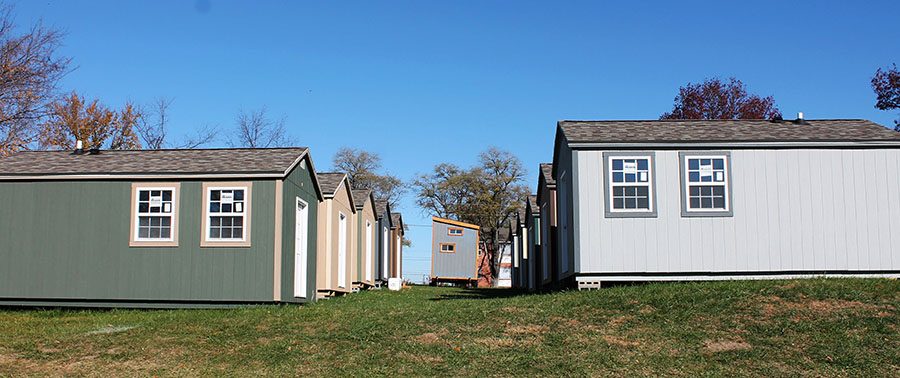Tiny homes being built to house homeless veterans
Veterans Community Project is building a tiny house community for homeless veterans, hoping to move vets in by April 2017.
The tiny house community is being built by the Veterans Community Project at 89th and Troost on Nov. 19. photo by Meghan Baker
December 12, 2016
story by Lily Manning
Fifty tiny homes, all 12 by 20 feet, across 4.2 acres of land near 89th and Troost Avenue. Each home with a bed, kitchen, bathroom and desk and the ability to transform thousands of lives in just a matter of years.
This is the vision for Veterans Village, a tiny house community being built by Veterans Community Project, a nonprofit headed by four combat veterans. The community will provide free transitional housing and services to homeless veterans in the Kansas City area. VCP is hoping to be able to house their first veterans by next April, with all the facilities being finished by winter 2017.
Veterans Community Project is an organization started by Chris Stout, Kevin Jamison, Bryan Meyer and Brandonn Mixon – all of whom are combat veterans themselves. The men saw homeless veterans as a crucial concern in Kansas City. Stout, an army veteran who has served tours in Iraq and Afghanistan, highlighted this factor in a news release issued earlier this year.
“We identified too many veterans suffering from PTSD and addictions who were going untreated and not doing well in traditional shelters,” Stout said. “We decided as [veterans] that we had to do something to help.”
This, along with a determination to “answer the unmet needs of homeless Veterans,” according to their website, served as inspiration for the project. According to Meyer, a Marine veteran who served for five years, the project has not been easy, but hard work gets them through it.
“It is just the four of us that do this full-time so we’re kind of a small organization, but we bust our asses to get stuff done,” said Meyer.
Meyer started his own nonprofit organization that provided free legal services to veterans when he was in law school. Through this, he met Stout, who then met Jamison, who then met Mixon. The four then started Veterans Community Project apart-timetime undertaking. This went on for a few months until Meyer quit his job at a law firm to work at VCP full-time.
A little over a year ago, the men recognized homeless veterans as a huge issue in Kansas City and started brainstorming ways they could house their fellow veterans when they fell upon the idea of tiny houses. The men felt the homes would be a better alternative for veterans than a traditional homeless shelter.
In a tiny home, they figure, the veterans have their own space for their own things, while in a homeless shelter, which is traditionally one large room with beds, they do not. At VCP, they believe that this space allows for a better time for homeless veterans to shift back into living on their own.
photos by Meghan Baker
[nggallery id=17052]
“Traditionally, this is meant to function as a classroom in order to teach these guys how to live on their own again and transition,” Meyer said. “It’s a lot of stuff that isn’t offered at a traditional homeless shelter and it’s little things that some people don’t think about.”
One of these “little things” is pets. Meyer stated a lack of wanting to give up a pet as one of the reasons some veterans are choosing to stay on the streets. In a traditional homeless shelter, the space does not allow for pets. In Veterans Village, pets are allowed.
“Especially for guys with trauma, if we’re talking about military homeless veterans, privacy in your own space and things like that are huge,” Meyer said. Tiny houses have been growing in popularity in recent years, which Meyer says has been the “kickstarter” for their cause.
“[The publicity tiny homes are receiving] has been incredible,” Meyer said. “We joke about it all the time, that we merged two of what we call ‘sexy subjects’ – homeless veterans and tiny homes.”
It is these “sexy subjects” that have helped the project gain nationwide attention – prompting Zach Giffin, host of the TV show “Tiny House Nation,” to come by and help build in October. Together, Giffin and VCP held a workshop where community volunteers and homeless veterans came together and built a tiny home in a day. This home is being raffled off as a way to build funds and publicity for the project.
Though the project has been branded as ‘Tiny homes for homeless veterans,’ Meyer said the project is more than just housing veterans, that VCP is really trying to tackle the underlying homelessness issue.
In order to do this, the men at VCP have plans to build a community center after the homes are finished. Here the veterans will be able to access medical, dental, legal and social services as well as laundry facilities, addiction counseling and job training. Meyer says all these services are necessary to addressing the underlying homelessness issue.
VCP differentiates itself from other veteran services by redefining what it means to be a veteran. In order to live in one of the tiny homes, VCP qualifies that you are street homeless and a veteran, which they define differently than the Veterans Association does.
“By veteran we have a very different definition of it than the VA does,” said Meyer. “For example, if you were in the National Guard, you’re not a veteran unless you were deployed. We don’t take that approach. We take the approach that if you took an oath to serve, you’re a veteran.”





